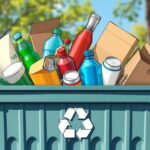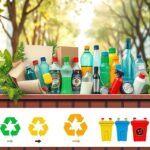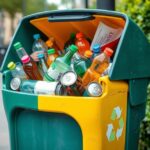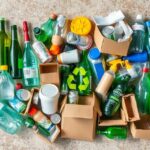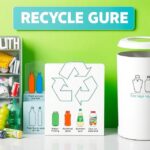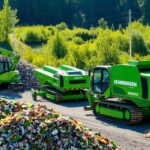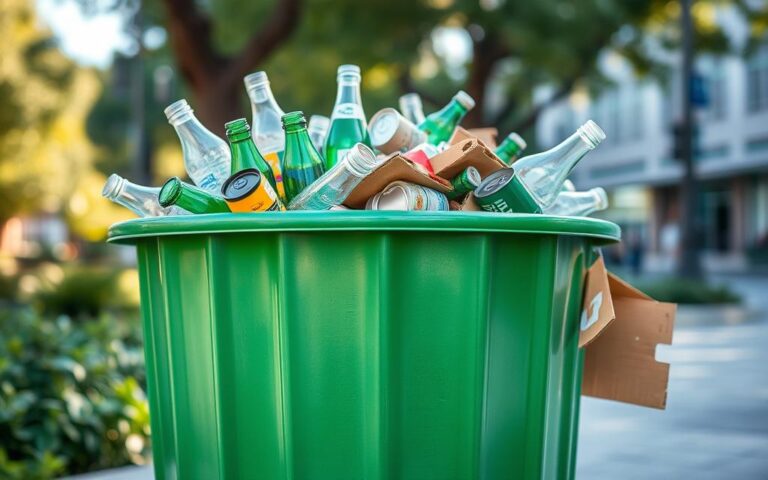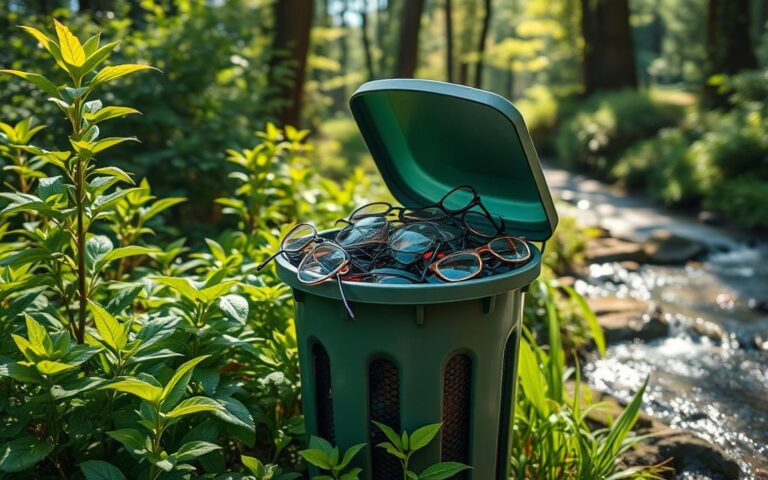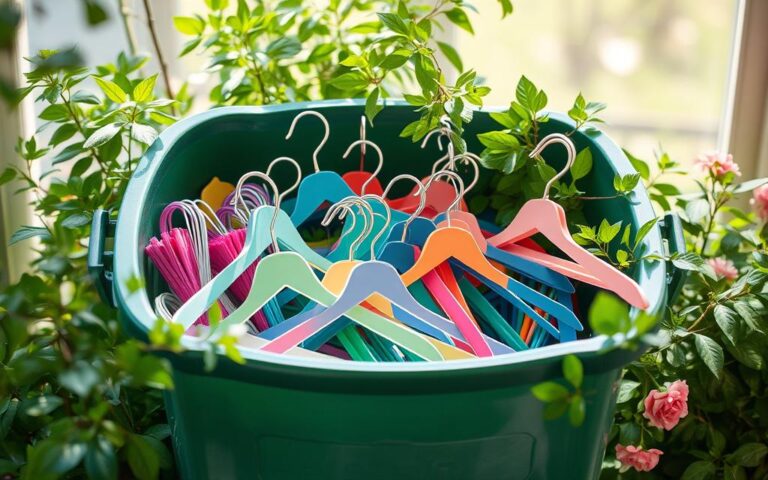What Can Go in Recycling Bins? Complete Guide
Recycling plays a key role in protecting our environment. It helps cut down waste and reduce carbon emissions. Knowing what items we can recycle is vital. It makes sure recycling efforts work well. Each year, Americans create a huge amount of waste. Surprisingly, about 94% of tossed food ends up in landfills. This adds to the harmful greenhouse gas emissions. Moreover, only about 35% of U.S. waste gets recycled. This shows we have a lot of room to improve our recycling habits.
If you want to help the planet, understanding recycling is crucial. Wrong sorting can ruin recycling efforts by contaminating the materials. By identifying what can be recycled and preparing it correctly, we make recycling more effective. This guide offers detailed advice on what goes into recycling bins. It helps us learn about the materials that can be recycled and the right way to do it. By working together, we can fight waste and help our earth stay green.
Introduction to Recycling
Recycling is key to handling waste today. It greatly cuts down the waste heading to landfills. Through saving natural resources and reducing pollution, recycling helps our planet.
Many places now have easy curbside recycling schemes. These encourage people to recycle more. However, the wrong kind of recycling is still an issue. Teaching everyone about what can be recycled is crucial. This ensures that recycling efforts are effective.
Items need to be clean before recycling. Research shows that one dirty item can spoil a whole truckload of recyclables. So, make sure to wash containers well. Just a small amount of leftover liquid can make an item unrecyclable.
Also, never put recyclables in tied bags or bundles. This can break the recycling equipment. Items that are mixed together must be sorted correctly too. This helps in processing them the right way.
| Material Type | Recyclable Items | Non-Recyclable Items |
|---|---|---|
| Paper | Newspapers, magazines, cardboard, office paper | Wet or contaminated paper |
| Plastic | PET (1), HDPE (2), LDPE (4), PP (5) | Plastic bags, single-use plastic cutlery |
| Aluminium & Steel | Food and beverage cans | Empty aerosol cans with hazardous contents |
| Textiles | Old clothing, fabric scraps | Dirty or stained textiles |
| Hazardous Waste | N/A | Paint, pesticides, chemicals |
Understanding the rules for recycling is important. It helps avoid problems and makes recycling work better. By doing this, we can make local recycling programs more efficient and effective.
Understanding Curbside Recycling Services
Curbside recycling is vital in waste management across communities. It’s available in all U.S. states. Residents can easily dispose of recyclables with their rubbish. However, the recycling rules differ by location. Some places require it by law, while in others it’s optional.

These programs usually take various materials like plastics, metals, and paper. Most accept plastics labelled #1 to #7. Yet, be careful. Sadly, about 25% of items in recycling bins are not suitable for curbside recycling. Knowing what items are accepted is crucial.
The cost for recycling services ranges from £8 to £15 monthly. Good participation from the community is key to its success. Since wrong items can contaminate the recycling process, education on proper recycling is a focus.
Even though curbside recycling is convenient, not all items should go in the bin. Heavy-duty plastics, appliances, and certain glass types need special handling. Always check local recycling guidelines to recycle correctly.
What Can Go in Recycling Bins?
Knowing what goes into recycling bins is key to managing waste well. Many home items can be recycled. Yet, it’s vital to know which materials are accepted. Good recycling prep makes the process more efficient.
Accepted Materials for Recycling
Here’s a list of recyclable materials:
- Plastic bottles and containers
- Aluminium cans
- Glass bottles and jars
- Paper
- Metal containers
- Milk and juice cartons
- Cardboard
- Paperboard boxes
These items often go in the blue recycling bin. Knowing what’s recyclable helps our planet.
Importance of Cleaning and Preparing Items
Cleaning before recycling is key. Clean items stop food from spoiling the batch. Items with food can lead to extra charges due to contamination.
Rinsing containers and removing any food ensures successful recycling.
Clean recycling helps the environment. Proper disposal of non-recyclables alongside recyclables makes Earth greener.
| Type of Material | Recyclable | Preparation Required |
|---|---|---|
| Plastic Bottles | Yes | Rinse and remove caps |
| Aluminium Cans | Yes | Rinse |
| Glass Jars | Yes | Rinse |
| Cardboard | Yes | Flatten and dry |
| Food Waste | No | N/A |
| Plastic Bags | No (after August 2024) | N/A |
The Do’s and Don’ts of Recycling
Understanding recycling’s do’s and don’ts improves recycling program efficiency. Many people have recycling misconceptions. These lead to serious recycling stream problems. What is recyclable is often misunderstood, causing contamination and wrong disposal. It’s important for anyone wanting to make a difference to know common mistakes and learn recycling tips.
Common Misconceptions about Recyclables
Many think items with a recycling symbol are recyclable. This recycling misconception causes a lot of bin contamination. Studies show less than 9% of plastics are recyclable. Misplaced items, like plastic bags, cups, and utensils, are common. Another myth is about paper recycling. People believe staples must be removed, but paper mills can process them. Educating about recycling tips clears up these myths and explains what actually can be recycled.
Avoiding Contaminants in Your Recycling Bin
Contamination dramatically impacts recycling programs. In the US, about 25% of items in recycling bins aren’t recyclable, leading to a lot of recycling contamination. Simple steps, like cleaning containers and avoiding plastic bags, help keep recycling clean. Yard waste and organics in recycling bins also cause problems. Right recycling behaviors not only improve the process but also cut contamination costs, saving about $55 per ton at recycling facilities. Cities offer e-waste services, and signs at work educate on recycling correctly.
Recycling Specific Items: Plastic, Glass, and Paper
Understanding how to recycle plastics, glass, and paper is key to helping the planet. It’s important to know what can and cannot be recycled for effective results. This ensures our efforts help create a better future.
Recycling Plastics: What to Include and What to Omit
Knowing the different types of plastics is essential for recycling. Curbside recycling programs often accept plastics marked #1 to #7. Plastics #1 (PET) and #2 (HDPE) are usually okay, but #3 (PVC) and #4 (LDPE) might not be. Items like plastic bags can contaminate recycling, so they should be taken to specific drop-off locations.
Handling Glass in Your Recycling Bin
Recycling glass can be tricky because it can break. Although glass bottles and jars are recyclable, some curbside programs don’t accept glass to avoid hazards. Always check your local rules to make sure you’re recycling glass correctly and safely.
Paper Recycling Best Practices
To recycle paper effectively, it needs to be clean and dry. Cardboard should be flattened and cut to fit easily in recycling bins. Newspapers, magazines, and non-food paper bags are usually good to recycle. However, some items like wrapping paper or paper towels should be kept out of the bin to keep the recycled materials clean.
What Can’t Go in the Recycling Bin?
Knowing what you can’t put in recycling bins is key. Items that can’t be recycled can cause big problems. They can contaminate and end up in landfills.
Many of us put the wrong things in our recycling bins. This makes it harder to recycle properly.
Common Non-Recyclable Items You Should Avoid
Some everyday items should not go in recycling bins. Things like leftover food, plastic wrap, and batteries can be harmful. A fire at a Wisconsin recycling plant was started by a wrongly thrown away battery.
Paper products with food on them also cause trouble. They make the quality of recycled materials worse.
- Unwashed plastic or glass items: Risks include organic contamination, which can promote dangerous moulds.
- Electronics: Devices like laptops and batteries should be handled through dedicated recycling programmes, as some components require special disposal.
- Light bulbs: Despite being glass, many contain hazardous materials that necessitate proper disposal methods.
- Non-flattened cardboard boxes: These can complicate processing at recycling facilities.
- Plastics labelled 3 to 7: Items like squeeze bottles and coffee cup lids often fail to meet recycling standards.
- Food-contaminated packaging: Many curbside programmes reject items like potato chip bags and plastic utensils.
Special Items: Where to Recycle Them
There are specific places for recycling items not taken at the curb. Electronics can be recycled at certain facilities. This helps recover valuable materials and avoids harm to the environment.
Finding out where to recycle special items is important. It helps our recycling efforts work better for everyone.
For tips on discarding non-recyclable items and finding local recycling options, visit this useful site.
Conclusion
Knowing what can and cannot be recycled is key to better recycling. We conserve resources and help the environment by recycling right. Studies show that good recycling can half the waste we send to landfills each year. This greatly cuts down the trash in our communities.
It’s also vital to raise recycling awareness. This helps everyone, including businesses, to recycle smarter. By sticking to local rules and keeping things clean, businesses can recycle more. They might even cut waste disposal costs by 20%. Good recycling practices boost a company’s green image, attracting customers who care about the planet.
The world’s waste problem is growing as the population increases. This makes living sustainably more important than ever. Embracing the “Three Rs”—Reduce, Reuse, Recycle—helps our local and global environment. By learning and following recycling rules, we can create a greener future for us all.
FAQ
What can I put in my recycling bin?
In your recycling bin, you can place plastic containers, glass jars, metal cans, and cardboard. But the items you can recycle can change depending on where you live. It’s very important to look up your local recycling rules.
Why is it important to clean recyclable items before placing them in the bin?
Cleaning items like food containers is key to stop contamination. If items are dirty, they can spoil the whole recycling process. This might mean a lot of items can’t be recycled.
Are plastics the only materials that can be recycled?
Plastics are just one type of material you can recycle. Glass, paper, and metals are also recyclable. But, it’s key to know which specific types your local program will take.
What are some common misconceptions about recyclable items?
Some people think plastic bags and food-soiled materials are recyclable. Actually, these should not go in your recycling bin. They can mess up the recycling process.
How do I dispose of items that cannot be recycled?
For non-recyclable things like plastic wrap and food waste, follow local disposal rules. Check if your area has special recycling for electronics and appliances.
What should I do with special items that don’t belong in curbside recycling?
Special items, including batteries and certain electronics, need particular care. Look for recycling days or drop-off spots in your area. Your community might have special programs for these.
How does proper recycling contribute to environmental sustainability?
Recycling right cuts down on landfill waste and saves precious resources. It also reduces pollution. By recycling more, we can lower harmful carbon emissions and aid sustainability efforts.



